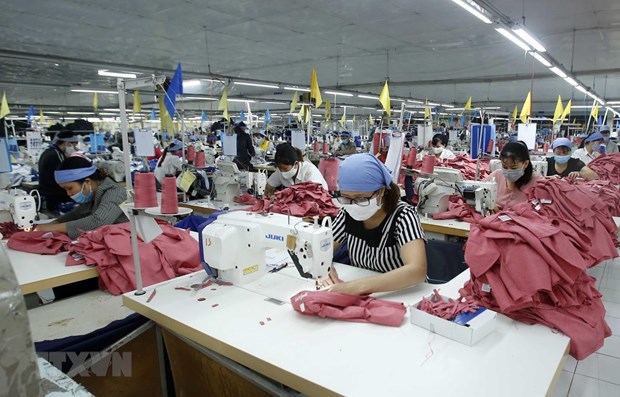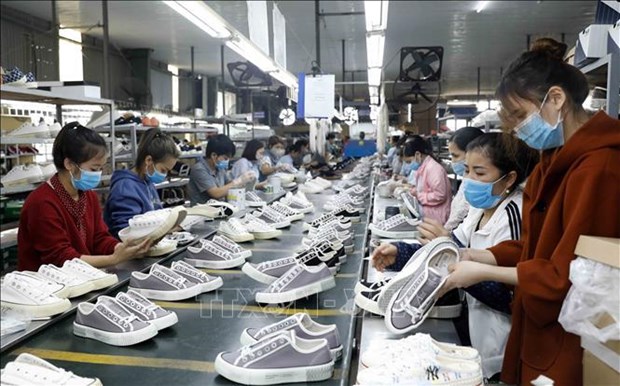The European Commission (EC) recently put forward a proposal for the textile and clothing industry, aiming to address global challenges such as climate change, biodiversity loss and environmental pollution.

Vietnam's textile, clothing and leather shoes industry is committed to meeting the green standard of the European market hinh anh 1. Figure Ziyue Tongshe
Vietnam Tongshe Hanoi - The European Commission (EC) recently put forward a proposal for the textile and clothing industry, aiming to address global challenges such as climate change, biodiversity loss and environmental pollution.
According to the proposal, textiles, clothing, leather and footwear products are one of the product groups that must meet the EC ecological design requirements.
Industry experts believe that, according to these new standards, enterprises must improve technology, meet the traceability of raw materials and environmental protection regulations in order to enter the EU market.
It is expected that the European Parliament and the Council will approve the ecological legislation in 2023 and other product group standards in 2024.
Europe was a traditional and important market for Vietnam's textile, clothing and footwear industries. After the EU Vietnam Free Trade Agreement (EVFTA) came into force, enterprises have made full use of the agreement to promote exports to the EU.
Pan Qingchun, vice president and secretary-general of Lefaso, said that the EU market has stricter requirements on product safety and environmental protection than other markets. Therefore, enterprises must earnestly implement the regulations.
Pan Qingchun said that in order to meet European standards, enterprises should improve the quality of human resources and production facilities, especially the use of clean energy and green technology.
The regulations on the origin of footwear in EVFTA are similar to the EU's new standards on the origin of Vietnamese leather and footwear products, so enterprises do not encounter too many difficulties in meeting the new regulations.
Pan Qingchun introduced that since the implementation of the EU Vietnam Free Trade Agreement, the leather and footwear industry has made full use of the benefits of the Agreement to promote exports. According to statistics, before that, Vietnam's leather and footwear exports to the EU accounted for 25% to 28% of the total exports, which has now increased to 30%.

Vietnam's textile, clothing and leather footwear industry is committed to meeting the green standard of the European market. The localization rate of leather footwear products hinh anh 2 was only 45% before. Figure Ziyue Tongshe
The production of raw materials in the leather shoes industry has made significant progress recently, both meeting the requirements of the country of origin and creating better added value.
The localization rate of leather footwear products used to be only 45%, but now it has reached more than 55%. For canvas shoes, the localization rate has reached 100%, and for sports shoes, it has reached 70% to 80%.
The EU is an important market for Vietnam's leather footwear and textile industry. However, enterprises must comply with safety standards when exporting to the EU, which has driven enterprises to invest in technology. The second is to meet the sustainable development standards related to environment and labor services. The enterprise must fulfill its rights and obligations with its employees. In terms of environment, we are committed to the use of clean energy and the application of green and advanced technologies.
As for green growth, Wu Dejiang, chairman of Vietnam Textile and Clothing Association, said that the number of textile and clothing enterprises using clean energy increased to 60-65%, mainly due to self purchased electricity or self built solar power supply. It is estimated that all textile and garment enterprises can achieve the goal of clean energy in the next 5 to 7 years.
The Vietnam Textile and Garment Association has suggested that the government approve the Development Strategy of Textile and Footwear Industry by 2030 and the Outlook for 2035 as soon as possible, commit to building large industrial parks with centralized wastewater treatment systems, advanced technology and green technology, attract textile printing and dyeing investment, solve the problem of fabric supply for clothing export, meet the requirements of origin, and make full use of the preferential tariff policies in a series of free trade agreements. A proposal was made to address global challenges such as climate change, biodiversity loss and environmental pollution.



